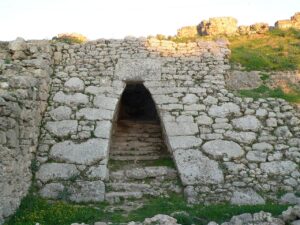
Ugarit Palace Entrance. By Disdero (talk · contribs) – Own work, CC BY 3.0, https://commons.wikimedia.org/w/index.php?curid=3354118
Drought, famine, earthquakes and, ultimately, fire ended civilization at Ugarit
About 1200 B.C., civilization in the then-known world seemed to come to an end. Major urban centers from Cyprus, Anatolia, and Egypt to Palestine and Amurru were destroyed or severely damaged. Entire ethnic groups disappeared. Thus concluded what archaeologists call the Late Bronze Age, the last major segment of the Bronze Age itself. In about 1200 B.C., the Iron Age began. At this time, according to most scholars, Israelite tribes settled in the hill country of Canaan (see James Muhly, “How Iron Technology Changed the Ancient World—And Gave the Philistines a Military Edge,” BAR 08-06).
Among the ancient cities destroyed at the end of the Late Bronze Age was Ugarit. For a time, Claude Schaeffer, the excavator of Ugarit, thought the city might have been destroyed by an invasion of the Sea Peoples who were related to the Philistines. Letters in the Ugaritic archives indicate that the Sea Peoples may indeed have invaded Anatolia. As the following excerpt indicates, however, toward the end of his life, Schaeffer abandoned this theory. This excerpt originally appeared in Ugaritica V, published in 1968. The translation from the French is by Michael David Coogan, who teaches Old Testament and Archaeology at Harvard University and is the author of Stories from Ancient Canaan (Even Briefer). This translation is published with permission of the Imprimerie Nationale, Paris, France, and of Mme. Claude Schaeffer.—Ed.
Beginning in our first season of excavations at Ras Shamra in 1929, we noted in our excavation diary the presence of a fine, powdery, homogeneous soil, pale yellow or more frequently whitish in color, which was characteristic of Ugarit’s last level. This layer had no internal stratification and in places was two meters [about six feet] thick. In this dry and powdery soil lay the remains of the buildings devastated by the earthquakes and by the fires of Ugarit’s last days. From the eastern edge of Ras Shamra’s extended hill, near the temple of Baal and Dagon, to the western limits at the seacoast where the palace, public buildings and luxurious private houses were located, everything was covered by this whitish-yellow dust layer. It is irrefutable evidence that Ugarit’s last days were hot and dry.
This dust layer is covered by layers of brown earth and debris and above those layers by surface soil consisting of a medium to dark brown humus which was not dusty but normally constituted. These darker, less dusty layers are clear proof of a damper climate than that which characterized Ugarit’s last days.
Read the rest of The Last Days of Ugarit in the online Biblical Archaeology Society Library.